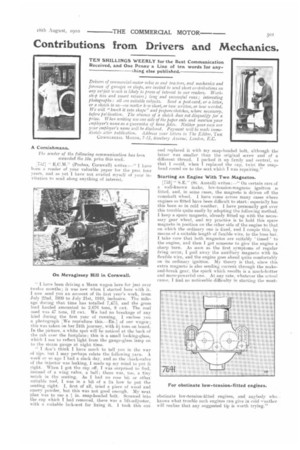Contributions from Drivers and Mechanics.
Page 23

If you've noticed an error in this article please click here to report it so we can fix it.
TEN SHILLINGS WEEKLY for the Best Communication Received, and One Penny a Line of ten words for any
thing else published.
Drivers of comniercial-motor vehic es and tra:lors, and mechanics and foremen of garages or shops, are invited to send short cootributions on any subject w.eich is likely to prove of interest to our readers. Work. shop tins and smart ref:airs ; long and successful runs ; interesting photographs : all are suitable subjects. Send a post-card, or a letter, or a sketch to us—no matter 11/2v short, or how written, or how worded. We will " knock it into shape" and prepare sketches, where necessary, before publication. The absence of a sketch does not disqualify for a prize. When writing use one side of the paper only and mention your employer's name as a guarantee of bona fides. Neither your own nor your employer's name zvill be disclosed. Payment will be made immediately alter Publication. Address your letters to The Editor, THE COMMERCIAL MOTOR, 7-15, Kosebery Avenue, London, E.C.
A Cornishmann.
The sender of the following communication has been awarded the 10s. prize this week.
52] " E.O.M." (Probus, Cornwall) writes :—" I have been a reader of your valuable paper for the past four years, and as yet I have not availed myself of your invitation to send along anything of interest.
" I have been driving a Mann wagon here for just over twelve months; it was new when I started here with it. I now send you an account of its first year's work, from July 22nd, 1909 to July 21st, 1910, inclusive. The mileage during that time has totalled 7,475, and the gross load hauled amounted to 2,676 tons, 8 cwt. The coal used was 47 tons, 12 cwt. We had no breakage of any kind during the first year of running. I enclose you a photograph [We reproduce this.—En.] of our wagon; this was taken on her 24th journey, with 4i tons on board_ In the picture, a white spot will be noticed at the back of the cab over the footplate; this is a small looking-glass, which I use to reflect light from the gauge-glass lamp on to the steam gauge at night time. " I don't think I have much to tell you in the way of tips, but I may perhaps relate the following yarn. A week or so ago I had a slack day, and as the ,..heek-valve of the injector was leaking, 1 made up my mind to put it. right. When I got the cap off, I was surprised to find, instead of a wing valve, a ball; there was, too, a tiny notch in the seating. As I had no rose bit or °then. suitable tool, I was in a bit of a fix how to put the seating right. I, first of all, tried a piece of wood and emery powder, but this was not good enough. My next plan was to use a in. snap-headed bolt. Screwed into the cap which I had removed, there was a lift-adjuster, with a suitable lock-nut for fixing it. I took this out,
and replaced it with my snap-headed bolt, although time latter was smaller than the original screw and of a different thread. I packed it up firmly and central, so that 1 could, when I replaced the cap, twist the snaphead round on to the seat which T was repairing."
Starting an Engine With Two Magnetos.
I_753] " S.E." (St. Austell) writes :—" On certain cars of a well-known make, low-tension-magneto ignition is fitted, and, in some cases, the magneto is driven off the camshaft wheel. 1 have come across many eases where engines so fitted have been difficult to start especially has this been so in cold weather. I have personally got over this trouble quite easily by adopting the following method. I keep a spare magneto, already fitted up with the necessary gear wheel, and my practice is to hold this spare magneto in position on the other side of the engine to that on which the ordinary one is fixed, and I couple this, by means of a suitable length of flexible wire, to the buss bar. I take care that both magnetos are suitably timed ' to the engine, and then I get someone to give the engine a sharp turn, As soon as the first symptoms of regular firing occur, I pull away the auxiliary magneto with its flexible wire, and the engine goes ahead quite comfortably on its ordinary ignition. My theory is that, since this extra. magneto is also sending current through the makeand-break gear, the spark which results is a much-hotter and more-powerful one. At any rate, whatever the actual cause, I find no noticeable difficulty in starling the most
obstinate low-tension-fitted engines, and anybody who knows what trouble such engines can give in cold sveather will realize that any suggested tip is worth trying."•
























